![]()
Murano Paperweights for Sale
![]()
Murano Paperweights for Sale
The glass paperweights on this page were made on the Island of Murano in Venice, Italy. Most were made between 1960 and 2000.
Venetian glass making dates back centuries and the Venetians are given credit for the earliest millefiori canes and paperweights in 1840s. More recently, paperweight making was revived in the 1930s and again in the 1960s.
There is no shopping cart on
this website. If you would like to purchase any of these
paperweights or need more information, please send an email to: aport@paperweights.com
| 1603 | Antique Franchini Type Aventurine
Venetian Murine Paperweight Scent Bottle. circa
1840-1880. This rare Franchini type miniature Venetian scent
bottle has two early murrine canes. On the front is a
murrine of a gondola. The murrine on the back depicts a
winged lion on water, or the Lion of St. Mark. This murrine
has a small fracture in the cane. The six-sided shape is
similar to known scent bottles made by Giacomo Franchini.
The glass is filled with aventurine and colored swirls. It
is in very good condition aside from the fractured murrine and has
normal age appropriate wear. There are also small fractures
on the neck. It does not have its original stopper and
hinged cap. Most likely it also originally had a
chain. Despite the similarity to known Franchini items, I am
selling this as "Franchini Type" as other glass artisans of the
period probably copied the work of the Franchini workshop. For comparable images, see the following pages in Miniature Masterpieces - Mosaic Glass 1838-1924 by Giovanni Sarpellon. A similar six-sided scent bottle appears in figure 520 on page 57. Similar gondola murrine appear in figures 425-439 on page 47. The lion of St. Mark appears in figure 422 on page 46. Note on condition: The scent bottle has several flaws. The cane of the Lion of St. Mark has a small fracture. There are also small fractures on the neck. The scent bottle does not have its original stopper, hinged cap, or chain. It also has age appropriate wear. Giacomo (Jacopo) Franchini (1827-1897) worked with his father Giovanni Battista Franchini (1804-1873) on the development of millefiori canes incorporating figurative designs as well as floral patterns. His is best known for his miniature portraits of the famous people of his time. He produced some of the most remarkable glass portraits and many were incorporated into scent bottles, walking stick handles and other objects, some useful and some purely decorative. His creative period ended in 1863 when he was confined to an asylum. For more details on the remarkable work produced by the Franchini family and others of the period, see the book Miniature Masterpieces - Mosaic Glass 1838-1924 by Giovanni Sarpellon. Miniature size: Just over
2 3/8" tall by just under 15/16" wide by 11/16" thick..
It weighs two ounces. The base is ground flat. For extra pictures, click on the picture at the right and the following links: Large picture$395 postage paid in the US. Click on the picture to see a larger image. |
Click
on the picture to see a larger image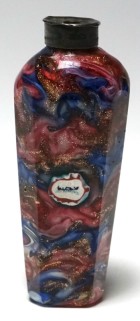 |
| 5242 | Magnum Murano Faceted Double Overlay
Three Row Concentric Millefiori Paperweight with 1854
Date. circa 1960-1970. A wonderful Murano three
row concentric millefiori paperweight with a red and white double
overlay. The 1854 date cane is surrounded by three rings of
identical white cog canes with turquoise centers. The "1854"
date cane is either a fake date intended to deceive the buyer or
perhaps commemorative of a past event. This paperweight is
faceted with one large top facet and five side facets. The
top facet has an unusual cutting as does the base which is
polished flat and finished with a fancy star cut. Probably
made in the 1960s by Fratelli Toso. A classic design. Murano paperweights with fake dates are an interesting sub-collection. Some people collect these paperweights with the goal of getting examples of each date. Some dates correspond dates used in real antique French or American paperweights, but there are no antique paperweights known to have an 1854 date. This paperweight was made on the island of Murano in Venice, Italy. Venetian glass making dates back centuries and the Venetians are given credit for the earliest millefiori canes and paperweights in 1840s. More recently, paperweight making was revived in the 1930s and again in the 1960s. Fratelli Toso was started in 1854 by six brothers - Angelo Toso, Giovanni Toso, Ferdinando Toso, Carlo Toso, Gregorio Toso and Liberato Toso. They were joined by Ermanno Toso in 1924 who became artistic director. The Fratelli Toso company is well known for its use of colorful murrines and millefiori, particularly during the 1950's and earlier. In 1979, the company suffered a harsh economic crisis, forcing the owners to divide it into Antica Vetreria Fratelli Toso and Fratelli Toso International. In 1981, Fratelli Toso International filed for bankruptcy and closed its doors for good. Antica Vetreria Fratelli Toso, led by Arnoldo Toso, continued to operate. Very large size: 3 3/16" diameter by 2 1/8"
high. The base is polished flat and finished with a fancy
star cut. This paperweight is faceted with one large top
facet and five smaller side facets. The top facet has an
unusual cutting. For extra pictures, click on the picture at the right and the following links: Large picture$145 postage paid in the US. Click on the picture to see a larger image. |
Click
on the picture to see a larger image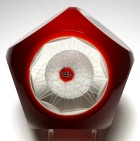 |
| 5128 | Large Murano Scramble
Paperweight. circa 1970. This fun scramble
paperweight is filled with light blue twist canes placed over a
ground of white lace or upset muslin. The blue twists have
gold aventurine edges. Unsigned. Note: Please ignore the white areas, they are glare from the lights. This paperweight has a faint scratch on the top of the dome. I also found a tiny (1/8") area on the side that appears to be debris in the glass. It cannot be felt and is not a bruise or pinprick. See the pictures for a closeup. Although many people collect scramble paperweights for their own merit, scrambles are also valuable tools for learning to identify the different colors and canes used by each factory. This paperweight was made on the island of Murano in Venice, Italy. Venetian glass making dates back centuries and the Venetians are given credit for the earliest millefiori canes and paperweights in 1840s. More recently, paperweight making was revived in the 1930s and again in the 1960s. Large Size: 3" diameter by just under 2
11/16" high. The base is ground flat. For extra pictures, click on the picture at the right and the following links: Large picture of the paperweight$65 postage paid in the US. Click on the picture to see a larger image. |
Click
on the picture to see a larger image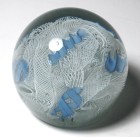 |
| 6058 | Colorful Murano Millefiori Paperweight
with Seven Large Complex Millefiori Cane Clusters.
circa 1960-1980. Colorful millefiori paperweight with a
closepacked design consisting of seven identical large complex
millefiori canes clusters. Each of the clusters consists of
a similar arrangement of seven millefiori canes surrounded by a
white and red crimp outer layer. The design is set over a
multi-colored frit ground. An interesting design.
This paperweight was made on the island of Murano in Venice, Italy. Venetian glass making dates back centuries and the Venetians are given credit for the earliest millefiori canes and paperweights in 1840s. More recently, paperweight making was revived in the 1930s and again in the 1960s. Small size: 2 1/4" diameter by just over 1 11/16"
high. The base is polished flat. For extra pictures, click on the picture at the right and the following links: Large picture$49 postage paid in the US. Click on the picture to see a larger image. |
Click on the picture
to see a larger image 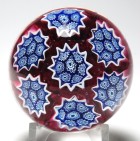 |
| 5304 | Large Murano Spaced Millefiori on Lace
Paperweight with Rare Signature Cane and KB Label - Probably by
Fratelli Toso. dated 1969. This
paperweight is a good example of a Murano spaced millefiori
paperweight with eight bright colored millefiori canes plus a rare
signature cane placed on a lace ground. The signature cane
reads "M.B 69" in blue letters on a white background. This
signature cane has been previously recorded and a variation
appears in Andrew Dohan's Dictionary of Paperweight Signature
Canes", revised edition. At this time, the precise
meaning of the signature cane is unknown. In addition, it
has a worn and faded silver foil label from KB (Koscherak
Brothers) stating that it is "AN ORIGINAL CREATION BY KB.
MADE IN ITALY".
This paperweight was made on the island of Murano in Venice, Italy. Venetian glass making dates back centuries and the Venetians are given credit for the earliest millefiori canes and paperweights in 1840s. More recently, paperweight making was revived in the 1930s and again in the 1960s. Koscherak Brothers (KB) were importers of Murano glass and Italian pottery from the 1950s until the late 1970s . At the time, they had a showroom at 225 Fifth Avenue, New York, NY. Some writers have observed that most of the Italian Glass imported under the KB Label was made by Fratelli Toso, but others have noted that KB labels appear on other good Italian glass including Barovier-Toso, Seguso, and others. KB is believed to have stopped importing Italian glass about 1977, but continued to exist in New York City until at least 1993. Large Size: 2 15/16" diameter by 2 5/8"
high. The base is ground flat. For extra pictures, click on the picture at the right and the following links: Large picture$195 postage paid in the US. Click on the picture to see a larger image. |
Click on the picture
to see a larger image 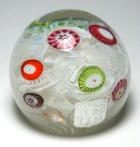 |
| 6263 | Magnum Murano Double Trefoil Millefiori
Paperweight. circa 1970-2005. Wonderful
example of a magnum Murano double trefoil millefiori
paperweight. It has two interlaced three lobe garlands of
complex blue and and burgundy millefiori canes. Each lobe
has either a multi-colored complex cane or a white bulls eye cane
in the center. There is also a white complex cane in the
center of the design. The entire design is placed over a
glittery aventurine ground. This rare design is hard to
find. The paperweight is unsigned, but I have been informed
by Murano experts that it was made by ALT or by 3-fiori in
Murano. A fun paperweight with great colors. Note: A previous owner or dealer incorrectly engraved the word "FRANCE" on the base. This paperweight was made on the island
of Murano in Venice, Italy. Venetian glass
making dates back centuries and the Venetians are given credit
for the earliest millefiori canes and paperweights in
1840s. More recently, paperweight making was revived in
the 1930s and again in the 1960s. Very large size: 3 9/16" diameter by 2 1/2"
high. The base is fire finished and ground concave in the
center. For extra pictures, click on the picture at the right and the following links: Large picture$145 postage paid in the US. Click on the picture to see a larger image. |
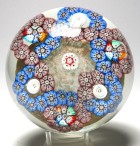 |
| 5644 | Large Colorful Murano Millefiori
Paperweight with Seven Large Flower Canes - Probably
Seguso. circa 1960-1980. Colorful
millefiori paperweight with a closepacked design consisting of
seven identical large flower canes. Each flower cane
is outlined in blue. The design is set on a clear
ground. Unsigned, but I believe this was made by
Seguso. An interesting design. There exist examples of this paperweight design with labels from the Archimede Seguso company in Murano "ARCHIMEDE SEGUSO MURANO MADE IN ITALY" and also from their showroom in Milan - "SEGUSO C. SORDA VITTORIA, 40, TEL. 799648, MILANO". This example does not have a label. This paperweight was made on the island
of Murano in Venice, Italy. Venetian glass
making dates back centuries and the Venetians are given credit
for the earliest millefiori canes and paperweights in
1840s. More recently, paperweight making was revived in
the 1930s and again in the 1960s. Archimede Seguso (1909-1999) was an Italian glass artist known for his intricate glass vases, necklaces, and sculptures. Spanning a wide range of forms and colors, his subject matter included animals and abstract shapes. He was part of an illustrious legacy of Italian glassmakers, their ancestry spanning over six centuries to the 14th century. Seguso notably led a revival of ancient Venetian glass-making techniques, specifically filigrana, which produced lattice-like patterns. Seguso ran the family business Seguso Vetri d'Arte, from 1937 to 1942. After 1942 he devoted his time to research and innovation and continued to produce many artistic breakthroughs. The Seguso company continues to produce glass today. Seguso works are included in many private and museum collections. Large size: 2 15/16" diameter by 1 7/8" high. The
base is polished flat. For extra pictures, click on the picture at the right and the following links: Large pictureSOLD. Click on the picture to see a larger image. |
Click on the picture
to see a larger image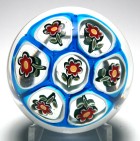 |
| 6002 | Magnum AVEM Murano Hollow Blown Crown
Paperweight. circa 1930-1960. Colorful
Murano crown paperweight made by Arte Vetraria Muranese
(AVEM). The paperweight is formed from 26 alternating
strands of white and pink twists. The pink twists have gold
aventurine borders to add sparkle. The white twists are made
up of a ribbon of five white rods. Eighteen colorful
millefiori canes make up the crown on top. There is a
remnant of a Murano label on the base. The
top of the dome has a small unevenness (from the making) which
cases a tiny bit of distortion. A wonderful large
example. This crown paperweight is unusual in that it is hollow blown with a large bubble in the center in the style of antique crown paperweights. Most modern crown paperweights are solid in the center. A great example for any collector of paperweights or Murano glass. Crown weights are considered by some to be the most exciting of all millefiori designs. They are extremely difficult to make. Hollow blown crown weights are even more difficult to make and are hard to find. This paperweight was made on the island of Murano in Venice, Italy. Venetian glass making dates back centuries and the Venetians are given credit for the earliest millefiori canes and paperweights in 1840s. More recently, paperweight making was revived in the 1930s and again in the 1960s. A.V.E.M. or Arte Vetraria Muranese was founded on the Island of Murano in Venice, Italy in 1932. They were no longer producing glass in 2003. For more information see page 9 of the book Murano Glass Century 20 by Leslie Pina. Very large size: Just over 3 1/2" diameter
by just over 2 15/16" high. The base is polished flat and
hollow ground in the center. This paperweight weighs 28
ounces. For extra pictures, click on the picture at the right and the following links: Large pictureSOLD. Click on the picture to see a larger image. |
Click on the picture
to see a larger image 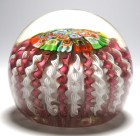 |
|
|
Vintage Murano Concentric Paperweight with
1869 Date. circa 1930-1960. Vintage
concentric design with pedestal base and fake 1869 date. It
has five rings of cog and floral canes around the 1869 date
cane. This is a hard to find example of an early Murano
weight that was intended to fool collectors.
A similar paperweight is shown in Figures 69 & 71, page 42 of Selman's first book Paperweights for Collectors Size: 3"” diameter by 3 1/8” high. The
bottom is fire finished. For extra pictures, click on the picture at the right and the following links: Large picture of the paperweight$195 postage paid in the US. Click on the picture to see a larger image. |
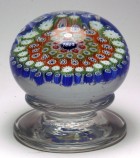 |
|
|
Rare Magnum Paolo Venini Closepacked
Millefiori Paperweight. circa 1930-1959. Very
large colorful Paoli Venini closepacked millefiori
paperweight. The design is placed over a clear ground.
Some of the millefiori canes are tipped on their side. This
paperweight has a low profile (see side view). An important
early 20th century paperweight from Murano. Several experts have advised me that this paperweight was made by Paola Venini. Most of his paperweights are not signed, but he also made signed mirrors with millefiori borders containing the same millefiori canes. This paperweight was made on the island of Murano in Venice, Italy. Venetian glass making dates back centuries and the Venetians are given credit for the earliest millefiori canes and paperweights in 1840s. More recently, paperweight making was revived in the 1930s and again in the 1960s. Paolo Venini (1895-1959) was born in Cusano, Italy. As a young man he studied law in Milan. During the first war he was stationed near Venice where he became fascinated with the glass mosaics and stained glass of St. Mark’s cathedral. After the war he began a law practice but soon came under the influence of Venetian art and antiquities dealer Giacomo Cappellin who convinced the young Venini to join him as a business partner in a new Murano glass enterprise in 1921. The firm was incorporated in 1924 as Vetri Soffiati Muranesi Venini Cappelin & Co. The Venini company continued to operate after Paolo's death in 1959 and remains in operation today (2023). Very large size: Just under 4" diameter
by 2" high. The base is polished flat. There is the
remnant of the pontil scar on the base. For extra pictures, click on the picture at the right and the following links: Large picture$275 postage paid in the US. Click on the picture to see a larger image. |
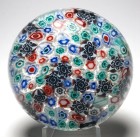 |
| 4438 | Large Fratelli Toso Murano Latticinio
and Twist Crown Paperweight with Millefiori Canes.
circa 1970. Wonderful example of a Murano swirl crown
paperweight formed from 24 colorful twists alternating in color
and arranged in a swirl. There are also three large
millefiori canes. Every other twist is a white latticinio
twist. Alternating colors are blue, green, red, pink,
and yellow. The yellow and pink twists have gold aventurine
edges. This paperweight was made by Fratelli Toso. A
fun paperweight with brilliant colors. Technically a crown weight should have a crown millefiori or group of millefiori on top. This weight does not. Crown weights are considered by some to be the most exciting of all millefiori designs. They are extremely difficult to make. Pedestal crowns are the most desirable.
This paperweight was made on the island of Murano in Venice, Italy. Venetian glass making dates back centuries and the Venetians are given credit for the earliest millefiori canes and paperweights in 1840s. More recently, paperweight making was revived in the 1930s and again in the 1960s. Fratelli Toso was started in 1854 by six brothers - Angelo Toso, Giovanni Toso, Ferdinando Toso, Carlo Toso, Gregorio Toso and Liberato Toso. They were joined by Ermanno Toso in 1924 who became artistic director. The Fratelli Toso company is well known for its use of colorful murrines and millefiori, particularly during the 1950's and earlier. In 1979, the company suffered a harsh economic crisis, forcing the owners to divide it into Antica Vetreria Fratelli Toso and Fratelli Toso International. In 1981, Fratelli Toso International filed for bankruptcy and closed its doors for good. Antica Vetreria Fratelli Toso, led by Arnoldo Toso, continued to operate. Very large size: 3 1/16" diameter by 2 5/8"
high. The base is polished flat. For extra pictures, click on the picture at the right and the following links: Large pictureSOLD. Click on the picture to see a larger image. |
Click
on the picture to see a larger image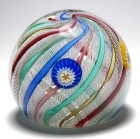 |
| 5990 | Large Fratelli Toso Murano Red White and
Blue Concentric Paperweight - with label. circa
1960-1970. Wonderful example of a Murano close packed
concentric millefiori paperweight. The design is simple,
with two rings of large red, white, and blue cog canes with clear
centers. The outer ring consists of twelve blue and white
canes. The inner ring consists of six red and white
canes. And there is a blue and white cane in the
center. This paperweight was made by Fratelli Toso and has a
worn Fratelli Toso silver foil label with a conjoined "ft" and
"MADE IN ITALY MURANO GLASS". A fun paperweight with great
colors. Note on condition: This paperweight has a slight dimple on top along with a faint 1" scratch on top (see picture). And a rough area next to the base (see another picture). I also found a tiny nick on the side which I couldn't capture in a picture. This paperweight was made on the island of Murano in Venice, Italy. Venetian glass making dates back centuries and the Venetians are given credit for the earliest millefiori canes and paperweights in 1840s. More recently, paperweight making was revived in the 1930s and again in the 1960s. Fratelli Toso was started in 1854 by six brothers - Angelo Toso, Giovanni Toso, Ferdinando Toso, Carlo Toso, Gregorio Toso and Liberato Toso. They were joined by Ermanno Toso in 1924 who became artistic director. The Fratelli Toso company is well known for its use of colorful murrines and millefiori, particularly during the 1950's and earlier. In 1979, the company suffered a harsh economic crisis, forcing the owners to divide it into Antica Vetreria Fratelli Toso and Fratelli Toso International. In 1981, Fratelli Toso International filed for bankruptcy and closed its doors for good. Antica Vetreria Fratelli Toso, led by Arnoldo Toso, continued to operate. Large size: 3 1/8" diameter by just under 2
11/16" high. The base is polished flat. For extra pictures, click on the picture at the right and the following links: Large pictureSOLD. Click on the picture to see a larger image. |
Click on the picture to see a larger image 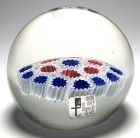 |
| 5645 | Magnum Murano Collie Paperweight - with
label. circa 1960-1980. Wonderful example
of a Murano ceramic decal paperweight with a colored collie
image. The image is created using a ceramic decal or
transfer applied to a translucent light blue ground and then
encased in clear glass. When heated the transfer burns off
leaving just the image. It is signed with a generic Murano
red and silver circular foil label "MADE IN Murano ITALY".
The exact factory is unknown to me, but I guarantee this is an
authentic Murano product. This paperweight was made on the island of Murano in Venice, Italy. Venetian glass making dates back centuries and the Venetians are given credit for the earliest millefiori canes and paperweights in 1840s. More recently, paperweight making was revived in the 1930s and again in the 1960s. Very large size: Just over 3 3/8" diameter by just
under 2 3/16" high. The base is polished flat. For extra pictures, click on the picture at the right and the following links: Large pictureSOLD. Click on the picture to see a larger image. |
Click
on the picture to see a larger image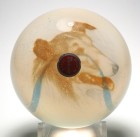
|
| 4445 | Large Murano Pear
Paperweight. circa 1950-1980. This
pear paperweight is made in the style of the antique New England
Glass Company pear paperweights with a variegated pear set on a
clear slightly oval cookie base. It appears to be hollow
blown just like those from NEGC. An excellent example of
this style. This paperweight was made on the island of Murano in Venice, Italy. Venetian glass making dates back centuries and the Venetians are given credit for the earliest millefiori canes and paperweights in 1840s. More recently, paperweight making was revived in the 1930s and again in the 1960s. Size: 2 3/4" diameter by 3 15/16" long by 2
15/16" high. The base 2 13/16" by 2 11/16" and is fire
finished. For extra pictures, click on the picture at the right and the following links: Large picture$69 postage paid in the US. Click on the picture to see a larger image. |
Click
on the picture to see a larger image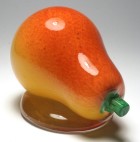 |
| 5698 | Magnum Murano Closepacked Millefiori
Paperweight - probably by Ferro & Lazzarini. circa
1960 - 1980. Colorful Murano paperweight with a great
assortment of closely packed colorful millefiori canes set over a
clear ground. I believe this was made at Ferro &
Lazzarini. A beautiful addition to any collection of
millefiori paperweights.
This paperweight was made on the island of Murano in Venice, Italy. Venetian glass making dates back centuries and the Venetians are given credit for the earliest millefiori canes and paperweights in 1840s. More recently, paperweight making was revived in the 1930s and again in the 1960s. The Ferro Eugenio & Co. glass factory was founded in 1929 on the island of Murano, Venice, Italy by Eugenio Ferro in partnership with Giovanni Lazzarini. After Eugenio died in 1947, the factory was managed by his young heirs. During this time, Giovanni Lazzarini became more involved and the company name was changed to Ferro & Lazzarini SRL. Starting in 2001, the factory has been managed by Dario Ferro, a direct descendant of Eugenio Ferro. Very large Size: Just under 3 7/16" diameter by 2
3/8" high. The base is polished flat. For extra pictures, click on the picture at the right and the following links: Large pictureSOLD. Added 1/24/2024 For more information about Murano paperweights, see my Murano Paperweights Web Page . Click on the picture to see a larger image. |
Click
on the picture to see a larger image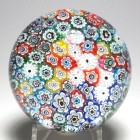 |
| 5703 | Murano Hollow Blown Closepacked Millefiori
Paperweight - with Two Labels. circa 1960 -
1980. Colorful Murano paperweight with a great assortment of
closely packed colorful millefiori canes on the surface of the
paperweight. The paperweight is hollow blown and weighs
about half of what a solid paperweight of this size would
weigh. It has two labels, a generic red and gold foil "MADE
IN Murano ITALY" label with scalloped edges and Koscherak Brothers
silver foil label "AN ORIGINAL CREATION BY KB MADE IN
ITALY". The millefiori canes were probably made by Ercole
Moretti or Effetre, but it is possible a different Murano studio
made this paperweight itself. A beautiful addition to any
collection of millefiori paperweights. The technique used to produce the inner core with millefiori canes on the surface is sometimes called a cane roll-up. The Murano firms of Fratelli Toso and Barovier & Toso produced objects with this technique. The millefiori canes are typical of Ercole Moretti which sold the millefiori and may have been the source of millefiori canes for this paperweight. This paperweight was made on the island of Murano in Venice, Italy. Venetian glass making dates back centuries and the Venetians are given credit for the earliest millefiori canes and paperweights in 1840s. More recently, paperweight making was revived in the 1930s and again in the 1960s. Koscherak Brothers (KB) were importers of Murano glass and Italian pottery from the 1950s until the late 1970s . At the time, they had a showroom at 225 Fifth Avenue, New York, NY. Some writers have observed that most of the Italian Glass imported under the KB Label was made by Fratelli Toso, but others have noted that KB labels appear on other good Italian glass including Barovier & Toso, Seguso, and others. KB is believed to have stopped importing Italian glass about 1977, but continued to exist in New York City until at least 1993. Ercole Moretti was established in 1911 on the initiative of three brothers, with the intention of producing two classic types of Venetian glass beads: the “Rosetta” and the mosaic ‘Millefiori”. The company, now managed by the founders’ grandchildren, has embraced various kinds of processes over the years to expand its product range. However, murrina glass has always been its core business. In their first years in operation, the Morettis focused on production of millefiori beads. In the 1970s they adapted to produce pendants and then launched a variety of products including dishes and ornaments in murrina. The company continues to operate today although there are two separate companies, Ercole Moretti and Effetre (previously called Effetre Moretti). Large size: 3" diameter by 2 1/4" high. The
base is fire finished with a depression in the center. For extra pictures, click on the picture at the right and the following links: Large pictureSOLD. Click on the picture to see a larger image. |
Click
on the picture to see a larger image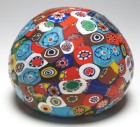 |
Back to Allan's Paperweights (www.paperweights.com)
Revised 9/30/2025 EI9